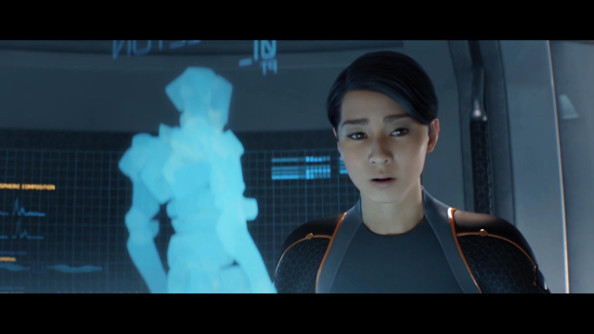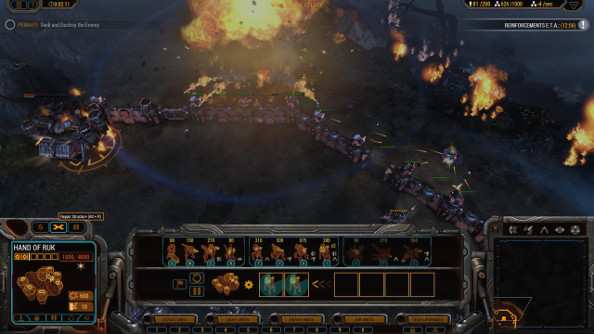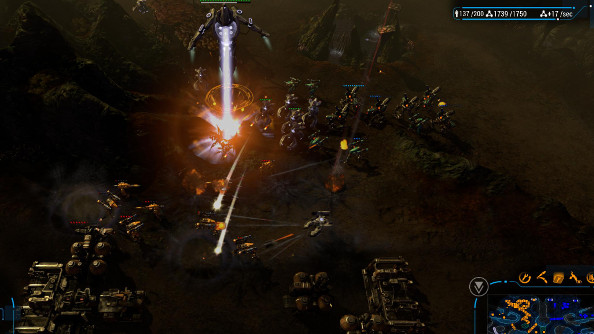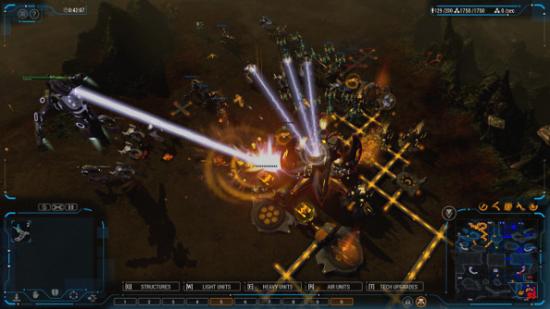Grey Goo boasts what is probably the most interesting clash of asymmetric armies since StarCraft 2. A major part of that is down to the titular Goo itself: it begins each match as a lone, amoeba-like blob of nanomachine particles and, as it begins oozing around the map collecting resources, it can spawn off smaller blobs that can transform into combat units or it can split itself and create another “Mother Goo” blob. The Goo faction never holds territory the way other factions can. It has no base or base defense. It can ignore impassable terrain, pouring down cliff-faces and crawling over ravines. I’ve never played anything in an RTS quite like it.
That’s Grey Goo in a nutshell. Beneath a retro-exterior is an RTS that’s been prepared by a team with years of experience under their belts, with genuine insight into what makes this genre tick, and why it sometimes chases people away. The result is a game that consistently delights with its near-flawless execution.
It’s hard to explain why Grey Goo is so great, because in many ways it’s a deeply conventional real-time strategy game in the vein of 90’s games like Command & Conquer or Dark Reign. There are no flashy innovations here, not really. It employs a brilliant approach to keyboard commands, but that’s not something that leaps out of a screenshot and seizes the imagination. It’s just something you notice and appreciate every time you play.
The Goo itself is probably the most distinctive thing about this game, but it has some terrific foils in the form of the Humans and the Beta. They’re not as flashy, but they’re still excellent examples of faction design. The Beta are the most traditional faction, and have the easiest time expanding onto the map, since they can build absolutely anywhere. If they get established around the map, they become a production powerhouse bolstered by some of the best defenses in the game.
The Humans are the opposite of the Goo and the Beta in key ways. They are pinned to one central base, and can only expand as far as their lines of conduit will extend. Within that base they can build tons of powerful turrets, but beyond its perimeter, its units and harvesters have to fend for themselves. On the other hand, the humans are also masters of teleportation, and can react very quickly to threats out on the map. Their devastatingly precise units tend to make quick work of armored units and fortifications.

Classic campaigning
The faction design tells a story all by itself, but Grey Goo is bolstered by a terrific and challenging single-player campaign. This is not a game that wastes your time, parceling out new units at a rate of one or two per mission. Nor does the AI wait for you to harvest enough resources to build an army that can come streamroll its bases. By the second or third mission of the single-player campaign, the AI is starting to hit you with early harassment and rushes. I was stunned to find myself forced to think about things like openings and build timings in a single-player campaign. That’s almost unheard-of in an RTS campaign.
I don’t think I’m the only one having this experience. Another reviewer mentioned to me that he was getting rolled by the AI in the first campaign, and my podcasting partner Troy Goodfellow mentioned the same thing the other night. These are RTS veterans who have been getting roughed-up by a single-player campaign.
On the other hand, there’s not much in-mission storytelling the way there is in StarCraft or even in Company of Heroes, and the overarching narrative unfolds so briskly that at times it feels rushed. It’s an odd feeling. Playing the campaign, it didn’t overstay its welcome.
Everything is well-executed here. The animations and voice acting are terrific, as are the Weta assisted art and designs. But as a story, it often felt like events were unfolding faster than the plotting and characterizations could justify them. This becomes intensely noticeable during the Human campaign.
That problems crop up in the Human campaign is not a major surprise. The Beta have an instantly sympathetic story: they’re on the run from a menacing enemy that has destroyed their civilization and nearly annihilated their people. The main character, Saruk, is well-acted and animated so that his people’s mix of fear, frustration, and hope is brought through in every scene.
The Humans, on the other hand, never really have their character clearly established. They have high-tech AIs that they engage with almost as if they were people. We know they use lots of robots to do their fighting. But we don’t really know what they’re doing out there at this distant planet in the first place, or what kind of society brought them to this point.
We’ve scarcely even gotten acquainted with the Humans in Grey Goo before the campaign springs what should a couple massive plot-twists on the main characters. But everything moves along so briskly that the stakes are never fully established, and so a few moments of ghastly realization and reconciliation don’t land the way they should. In terms of technical competence, the campaign is terrific, but as a narrative it seems overly condensed.

Home row
Tying together all of Grey Goo’s disparate elements is what is likely the best control scheme I’ve ever seen in an RTS. Grey Goo pins every aspect of production and construction to the QWERTY row, and it proves to be a godsend. Even when there’s a lot happening, it’s very easy to keep queueing up fresh units and rushing them into battle. With a scheme like that, even a scrub like me can feel like a macro-master. I’ve never played an RTS that feels as manageable as Grey Goo does.
And that’s probably going to be the most divisive thing about this game. If you’re someone who thinks that RTS games should be difficult to manage, and that a high degree of skill should be required for every aspect of the game, then Grey Goo is probably going to seem like child’s play. It’s a game where simply attack-moving your entire army will get you shockingly far, and where unit micromanagement is mostly a function of positioning and targeting. Terrain, likewise, is largely decorative. Aside from a cover effect conferred by forests, armies behave a bit like they’re clashing on a flat table.
But I find myself enchanted by Grey Goo’s “come one, come all” approach to RTS design. It’s a game where I have always had a great deal of fun learning and improving, never once did I feel like there was more happening than I could ever manage. And as I’ve gained more experience, I’ve discovered hidden depths to the simple unit archetypes and easy army management.
I do wish AI skirmishes were a better learning resource. The skirmish AI is wildly inconsistent compared to the crafty adversaries you meet in the campaign. While I’ve had some games where the AI lands some strong early-game punches, I’ve also seen it lose the plot. In one game against two hard AI players, they both sat in their bases with huge, max-population armies for much of the game, barely fighting on the map at all. When I finally started churning across the map with my game-ending super-army, I discovered they’d covered their half of the map in resource extractors, but invested no money in expanding their storage so they could hold on to a resource “bank.” And why were their armies just milling around like guests at a bad party? It was the kind of thing that made me wonder if the AI really understands how to play this game.
On the other hand, just a game or so prior to that, a normal AI player stomped me by building an absolute mob of Goo artillery units and just drowning my more balanced army in paralyzing long-range fire.

Multiplayer is, of course, a very different story. Auto-matching got me into games very quickly, usually within a minute or two. I mostly focused on custom games with friends, however, and Grey Goo’s Steam integration makes that very easy as well.
My biggest complaint with Grey Goo at the moment is that there just aren’t enough options for multiplayer, and there are no great victory conditions. The standard game-mode can degenerate into a whack-a-mole hunt for production and refinery buildings, and the Goo seem designed to make the endgame frustrating.
What’s far worse is the stingy number of maps and a four-player cap on multiplayer. With only a handful of four-player maps and slightly more two-player maps, Grey Goo doesn’t give you a whole lot of variety in multiplayer. I’m a bit shocked that big 3v3 and 4v4 games are impossible in Grey Goo, at least right now. Though perhaps there’s some technical limitations afflicting this game. I noticed major performance hits in four-player multiplayer games, especially once everyone had a sizeable army. It never dipped to a point where I’d have called it unplayable, but it definitely gets sluggish during some of Grey Goo’s biggest moments.
Still, these are flaws in an otherwise tremendous offering from Petroglyph. It’s the most purely fun, accessible RTS I’ve played in years. Whether it will stand the test of time like Company of Heroes or StarCraft is a question for five or ten years from now. What I can say now is that Grey Goo is a superb, cheerfully inviting real-time strategy game. It’s one I can recommend to both fans of the genre and people who have felt shut-out from RTS gaming these past few years.
